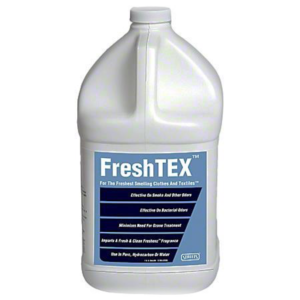General Care Tips for Textiles
Do Not rub; rather blot the spot!
If you spill something on a garment, always blot; do not rub! Rubbing some fabrics, especially silk, breaks the surface fibers. You won’t know it until you wash or dry clean that item, and find you have a frosted or a chalky appearance.
Do Not wait to clean stains!
Age is your enemy with successful stain removal. A coffee stain that happens today will come out much easier tomorrow than it will next week or month. The longer you wait, the greater the chance that the stain will be permanently set in the fabric. Also, some stains can break down cotton, linen, and silk fibers, causing thinning and holes in the fabric.
Knits over (not on) Hangers!
Knit garments should be folded and placed over the bar of the hanger, not hung from the shoulders. The weight of the fabric pulls the material down, which can stretch heavier knits out of shape.
What’s in your bathroom or laundry room?
Many household cleaning products contain bleach, ammonia or mild acids, which will cause color loss on clothing. If they are left in the clothes for a few days, thinning and fabric damage may develop.
Clean matching pieces together to avoid color distortion and variance
We all have suits and matching outfits that we do not always wear together. Sometimes you wear the skirt or pants with a different blouse, or the jacket with your favorite jeans and a fitted blouse or even a dress. Even though you don’t wear them together, you should always wash or dry clean matching pieces together. Solvent baths vary in temperature, purity, and moisture; so exposing them to the same conditions during processing eliminates the possibility that a slight color loss doesn’t give you two pieces that “almost match”.
Good practices in your laundry
If you are like most people, you do probably 3-5 loads of laundry; depending on colors and the amount of clothes to be cleaned.
- Whites should be washed in hot water to maintain whiteness and maximize soil and stain removal.
- Lights should be washed in warm temperatures to maintain brightness and stain removal.
- Darks should be washed in cold water to minimize dye fading and color loss. Consider dry cleaning dark shirts to maintain the look of these fabrics as long as possible.
- Don’t overload the machine, which can cause white streaks and local abrasion because the clothes don’t move around freely.
- Use proper water levels, for maximum soil removal. If water levels are too low for the load, soils will not be rinsed out, and can cause general discoloration and staining.
- Use the right amount of detergent. Using more detergent than necessary does not get your clothes any cleaner.
Odor-free dry cleaning
If your clothes have been properly dry cleaned, there should be no smell or odor-and no need to air them out. If there is an odor, the most likely culprit is dirty solvent that’s left a smelly residue behind; in rare cases, there may be a trace of solvent left in the garment. Either of these is unacceptable! If your dry cleaner can’t give you odor free garments, you need to find another cleaner.
Do I wash or dry clean my drapes?
Drapes are a big investment, and will require cleaning if you want to get long-term use from them.While drapes and curtains hang at the windows, they attract dust, cooking odors, and airborne particles. You should gently vacuum them every other month to prevent build-up. If the drapes get wet from rain at an open window or condensate on the windowpane, the moisture combined with the dust or smoke particles in the fabric can cause ugly water rings.
- If the care labels allow wet cleaning, a large, front-loading machine allows free movement and reduces bunching. Air dry, or tumble dry at low temperatures if recommended. Be sure to follow all care instructions -if there are none, you may want to have them dry cleaned professionally.
- If care labels recommend dry cleaning, have them processed by a professional; many offer take down/re-hang service.
- Some drapes are very difficult or impossible to remove from the window, such as drapes attached to wood frames or wall brackets. These may benefit from an on-site drapery cleaning process. Consult with your professional cleaner about this process.
Do I wash or dry clean my comforters and bedspreads?
Regular cleaning will keep your bed linens fresh and looking their best.
- If the care labels allow wet cleaning, a large, front-loading machine allows free movement and reduces bunching. Tumble dry in a large capacity machine, which will help fluff up the fiberfill or down filling material.
- If care labels recommend dry cleaning, take them to your professional drycleaner for proper handling.
- Some bed accessories may include duvets, dust ruffles, bolsters and throw pillows, etc. To ensure that multiple piece items in a set always match, they should be cleaned at the same time. This is advisable due to variable cleaning frequencies leading to a color variance or sheen.
Table linens
Table linens should be cleaned after each use. If they are put away without cleaning, stains can oxidize (become “set”), which can cause yellow, tan, or even brown stains. Further, some stains can cause fabric damage due to the acids in food or beverages.
If washing at home, do not use chlorine bleach; it is a reducing agent which can damage cotton and linen, and cause holes.
Spray starch at home cannot match the crisp feel and appearance you get when you take your tablecloths to be professionally laundered.
Seasonal storage tips
Before storing change of season garments, clean them to remove stains. This prevents stains from aging and discoloring. Food and beverage spots, body lotions, oils, and perspiration attract insect damage.
To minimize damage on garments and maximize their life, we suggest the following guidelines for long-term storage:
- Clean clothes before storing.
- Don’t store dirty clothes; light (UV rays affect colors), heat (attics-can cause yellowing), and humidity (basements-mildew and dank smells) all sets stains.
- Use garment storage that snap closed or bags that breathe.
Hand versus Machine wash
If a manufacturer’s recommendation allows for machine washing in a delicate/gentle cycle, the soil can be removed with slow agitation, with a short timeframe.
Hand washing uses a gentle squeezing action by reducing agitation. If hand-washable garments are machine washed in a gentle cycle, agitation can be further reduced by putting the item in a net bag. Read care labels with caution that shifts the assumption of responsibility to they who make the decision.
Aerosols and club soda have hidden risks!
Your mother or grandmother may have handed down home remedies for difficult stains, but hidden risks may cause more problems than they solve. Aerosols may contain alcohol, or other “thinners”, that allow products to be easily dispersed. Alcohols, oils, resins, or lanolin can cause color damage, especially on silk; or lead to additional stain issues.
Club soda has nitrites or nitrates that can cause chemical reaction with food acid and spices to set stains rather than eliminate them, or damage delicate fabrics which may be moisture sensitive.
Perspiration-another culprit in color loss and fabric damage
Perspiration and body oils are a pervasive source of color loss and fabric damage, due to the acids and salts in these secretions. Deodorants and antiperspirants that we use to combat this natural process may cause permanent damage. Most commonly, the overuse of these products or infrequent cleaning leads to a residue build-up. The deodorants typically contain alkalis; anti-perspirants typically contain acids; both will affect color fairly quickly. To prevent chemical damage, do not overuse the product, and allow it (along with colognes, after-shaves, body sprays, hair sprays, etc.) to dry completely before dressing. Clean frequently to reduce residue build-up. Wear dress shields with silk garments.
Wash those garments with care labels that advise wet cleaning safety, as soon as possible after wearing. Soaking in an enzyme presoak, or using an enzyme based detergent, may be necessary. If still soiled, a 3% hydrogen peroxide or chlorine bleach, according to care label instructions. Before using, test for colorfastness by applying to an inner seam or other non-noticeable area.
Does frequent dry cleaning affect garment condition or lifespan?
NO; rather, frequent cleaning prolongs the life of a garment. Not only do stains set with age, making the garment less serviceable, but ground-in dirt and soil can act as an abrasive, causing rapid wear of fibers. In addition, insects are attracted to food or drink stains in clothes, and will eat holes in them.
However, over-pressing, which usually results from not changing foam pads on presses frequently enough, can cause a flattened appearance, to the point of having a glazed, shiny appearance on silks and gabardine wools.





